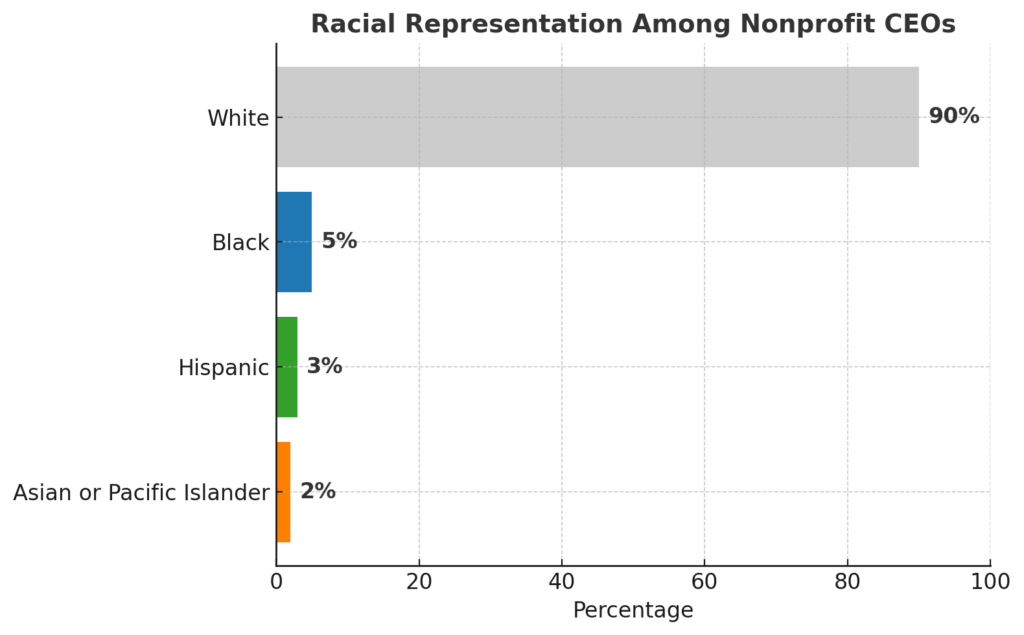Despite their mission to serve diverse communities, many nonprofits face internal challenges in creating inclusive and representative leadership teams. Diversity, equity, and inclusion (DEI) are core values in many nonprofit organizations, but the path to fully integrating them, especially within a nonprofit organization and leadership itself, is often unclear, under-resourced, or simply overlooked.
Nonprofit leadership training programs can play a pivotal role in addressing these complex challenges with nonprofit professionals. When tailored with DEI principles, nonprofit leadership development programs become a powerful tool for creating more equitable, innovative, and community-focused nonprofit organizations.
This article explores how training nonprofit leaders with a DEI lens not only addresses current gaps and challenges in nonprofit management and nonprofit governance, but also strengthens long-term organizational impact.
The Benefits of Diversity and Inclusion in Nonprofits
1. Increased Innovation and Creativity
Diverse leadership teams bring a mix of experiences, skills, cultural insights, leadership style and problem-solving approaches to nonprofit governance, management and organization. This blend fosters creativity, leading to more innovative programs and services.
Organizations with diverse leadership teams are more likely to experience significant market gains. For instance, companies with two-dimensional diversity—combining inherent and acquired diversity traits—are 45% likely to report a growth in market share and 70% likely to capture new markets (Inside NKU). This highlights the strategic advantage of fostering diversity in leadership roles to drive business expansion and innovation.

When a nonprofit organization and leadership also reflects a range of various leadership skills and perspectives, nonprofits are better equipped to adapt, grow, and address complex societal challenges.
2. Stronger Community Representation
Nonprofits exist to serve. When nonprofit management, mission and leadership more mirrors the demographics of the communities they serve, they build trust, deeper trust and more authentic relationships.
“Diverse leadership helps nonprofits better understand and serve their communities.”
This alignment ensures services are not only culturally competent but also grounded in lived experiences, improving effectiveness and relevance.
3. Improved Staff Engagement and Retention
An inclusive workplace boosts morale and encourages staff to bring their full selves to work. Employees and management who feel seen, valued, and supported are more likely to be engaged.
Inclusive workplaces not only foster a positive environment but also experience significant benefits in terms of employee engagement and retention. For instance, organizations with inclusive cultures are more likely to see increased employee engagement and retention rates.

According to Deloitte, inclusive teams are 17% more likely to report being high-performing, and inclusive companies are more likely to exceed financial targets, which indirectly supports the idea that inclusivity enhances engagement and retention (Deloitte via Loeble Leadership). Additionally, research highlights that DEI initiatives can lead to a 50% reduction in turnover risk, underscoring the importance of inclusivity in retaining talent (British Council).
Key Challenges in Building Diverse Nonprofit Leadership
1. Underrepresentation in Leadership Roles
Despite progress in other third sector sectors, leadership in nonprofits remains largely homogeneous. People of color, women, LGBTQ+ individuals, and people with disabilities remain underrepresented in executive and other top executive director and board members’ leadership positions.
Nonprofit leadership remains predominantly white, with only a small percentage of CEOs representing diverse backgrounds. For instance, as of recent reports, only about 5% of nonprofit CEOs were Black, 3% Hispanic, and 2% Asian or Pacific Islander (The Conversation).

This lack of diversity is concerning, as it can hinder nonprofits’ ability to effectively serve and understand the needs of diverse communities. According to BoardSource, whites fill a significant majority of board seats and CEO positions, highlighting the need for greater diversity in nonprofit leadership (Philanthropy.com).
This disparity limits the perspectives guiding a nonprofit organization in management, leadership development and decision-making and can create disconnects with the communities being served by nonprofit leaders and organization.
2. Limited Resources for DEI Programs
Nonprofits often operate with tight budgets and limited capacity to develop them. While DEI is a priority investment for organizations, investing in comprehensive programs can feel out of reach.
“Nonprofits want to move the needle on diversity, but the resources just aren’t there.”
This makes it essential for emerging leaders to incorporate DEI into existing professional development, leadership and nonprofit professional development,, and professional development structures.
3. Structural and Cultural Barriers
Unconscious bias, resistance to systemic change, and institutional norms can slow down DEI progress. Even well-meaning organizations may inadvertently maintain the status quo.
A nonprofit that promotes equity may still default to informal networks for board recruitment—excluding candidates who don’t “fit” existing leadership profiles.
Strategies for Fostering Diversity and Inclusion Through Nonprofit Leadership Training
Nonprofit leadership training that integrates DEI principles helps organizations address systemic challenges and equips leaders with the knowledge and tools to make organizations lead more inclusively.
1. Conduct Diversity and Inclusion Assessments
Before training begins, organizations should evaluate current DEI practices and representation gaps.
A diversity audit can uncover disparities in recruitment, retention, and leadership development pipelines.
These insights help us see new opportunities to develop and further programs and research that shape targeted, measurable interventions.
2. Offer Targeted DEI Training Modules
Training for professionals should go beyond general knowledge, skills, leadership skills, and management skills to include these skills:
Unconscious bias training
Cultural competency
Inclusive communication
Anti-racism and equity frameworks
While DEI training programs aim to reduce implicit bias, their effectiveness can vary. Some research suggests that certain approaches, such as bias habit-breaking training, can lead to meaningful reductions in bias over time. However, the general consensus is that traditional diversity training often has limited long-term impact on reducing implicit bias. For instance, studies have shown that many diversity training programs do not yield sustained reductions in bias, and some may even activate bias or spark a backlash (Harvard Business Review).
This helps leaders make informed, empathetic decisions, leaders that make systemic change and foster equity.
3. Build Mentorship and Sponsorship Programs
Mentorship provides underrepresented staff with the support and guidance needed to grow into leadership roles. Sponsorship goes a step further—actively becoming emerging leaders and advocating for their advancement.
“Mentorship is not about charity—it’s about ensuring talent doesn’t go unnoticed.”
Programs and initiatives like these break down invisible barriers to professional and leadership development, enhance both and open doors for emerging leaders.
4. Create Actionable, Measurable DEI Plans
A plan without benchmarks is just a wish. Nonprofits must set clear goals and track progress.
Setting a goal to double board diversity within two years creates accountability and urgency.
Include DEI metrics in organizational evaluations and leadership reviews to reinforce their importance.
What Makes DEI Training Effective for Nonprofit Leaders
1. Interactive Learning Methods
Traditional presentations aren’t enough. Workshops, simulations, and scenario-based learning encourage active engagement.
Interactive training methods significantly enhance learning retention compared to traditional passive approaches. For instance, active learning strategies such as practice-by-doing and group discussions have retention rates ranging from 50 to 75%, far exceeding the meager retention rates of passive methods like lectures (Brighter Kashmir). This hands-on approach allows learners to directly apply what they have learned, leading to deeper understanding and better retention. Similarly, research shows that interactive learning can increase retention rates by up to 75% compared to traditional lecture-based approaches (LinkedIn).

Participants are more likely to absorb knowledge and develop and show leadership skills and explore and apply concepts when they’re part of the process.
2. Alignment with Mission and Values
DEI training should never feel like an external requirement—it should be integrated into the organization’s core management mission.
“Our DEI goals are directly tied to our mission of serving marginalized communities.”
This alignment ensures the training is embraced and implemented meaningfully.
3. Ongoing Resources and Reinforcement
A one-time leadership style training won’t cut it. Effective and leadership style professional development that includes leadership skills are:
Annual DEI refreshers
Peer accountability groups
DEI-focused leadership coaching
Feedback loops with staff and community members
A nonprofit that holds quarterly DEI roundtables ensures continuous reflection and improvement.
Case Studies: Nonprofits Leading the Way
A Model for Diversity and Inclusion
The Nonprofit Leadership Alliance offers the CNP program, which emphasizes the integration of diversity, equity, and inclusion (DEI) principles in nonprofit management. This program equips emerging leaders with the skills to operate effectively in diverse communities, ensuring long-term success and sustainability for nonprofits. By focusing on cultural competency and diversity, the CNP program helps nonprofits better address the needs of diverse communities, leading to increased community engagement and credibility (Nonprofit Leadership Alliance).
DEI-focused leadership programs yield measurable results when supported by executive commitment.
YWCA – Racial Equity Training Series
YWCA has been at the forefront of promoting racial equity through comprehensive training programs. By collaborating with local community and nonprofit leaders, YWCA has successfully delivered DEI training to numerous top nonprofit leaders and executives. These programs focus on anti-racism education and community engagement, aiming to equip leaders with the knowledge and skills necessary to address systemic inequities.
For instance, YWCA Central Massachusetts offers racial equity workshops that provide a foundational understanding of the systems that uphold racism. These workshops are facilitated by experts and can be customized to meet the needs of various organizations, ensuring that participants develop a deeper understanding of racial equity issues and how to address them (YWCA Central Massachusetts).
Similarly, YWCA Charleston’s Center for Racial Equity and Inclusion provides programming that creates safe spaces for uncomfortable conversations and healing, supporting racial equity and inclusion initiatives across different levels of society. These efforts highlight the importance of collaborative and community-driven approaches to racial equity training.
Community partnership and leadership buy-in are crucial for success.
Conclusion
Diversity and inclusion are not side projects—they are essential for a nonprofit organization to success. Nonprofit leadership training that prioritizes DEI creates ripple effects across entire organizations, driving better decisions, deeper community relationships, and a greater impact on social impact.
As the nonprofit management sector continues to evolve, investing in inclusive, effective leadership development is no longer optional—it’s a strategic imperative for nonprofit and social sector leaders.
If you want your nonprofit to reflect the communities you serve, start with your leadership. Embed DEI in your leadership style, training programs, for leaders, create intentional pathways for diverse talent, and hold leaders, yourself and new leaders accountable to real change.
With the right training and mindset, today’s top nonprofit sector, philanthropy, and social sector leaders can shape a more inclusive, equitable, and impactful tomorrow—one decision, one hire, and one conversation at a time.

A trailblazer in humanising leadership and building high-resilience teams. As a former United Nations Peacekeeper, he leverages his high-stakes experience to redefine leadership dynamics. With a career distinguished by numerous accolades, Joseph now helps organizations thrive through a human-centric approach, enhancing performance, productivity, and workplace culture.







